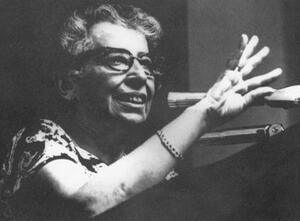Hannah Arendt's "Eichmann in Jerusalem" appears in "The New Yorker"
When Hannah Arendt published her first article about Adolf Eichmann's war crimes trial in The New Yorker in its February 16, 1963 issue, she was already a well-known political philosopher with a successful career and several books to her name. Born in Germany in 1906, Arendt studied theology and philosophy at the University of Marburg, where Martin Heidegger was on the faculty, and at the University of Heidelberg, where she completed a dissertation on St. Augustine.
Living amidst the political turmoil of Europe greatly shaped Arendt's studies and interests. Arendt shifted her focus away from theology to the rising antisemitism permeating the German polity in the 1930s. She began a study of the Enlightenment-era Jewish salon hostess Rachel Varnhagen, eventually published in 1958, in an attempt to understand the position of Jews within German culture and society. Arendt also became involved in the German Zionist Organization in 1933 and worked to bring Nazi atrocities to global attention. Arrested for investigating antisemitic propaganda, she befriended a Berlin jailer who enabled her escape.
Fleeing to Paris, Arendt worked with Youth Aliyah to help rescue Jewish children from the Third Reich by bringing them to Palestine. While in Paris, Arendt met her second husband and both were sent to internment camps in southern France. In 1941, both were able to reach America and reunite with Arendt's mother.
Once in America, Arendt began publishing political commentary and philosophy in journals such as Jewish Frontier and Partisan Review. After the war, Columbia historian Salo W. Baron put Arendt in charge of a program called Jewish Cultural Reconstruction, which was intended to recover and restore lost and damaged Jewish archives and cultural markers. The publication of her book, The Origins of Totalitarianism, in 1951, made Arendt an intellectual celebrity as America, searching for answers to the horrors of World War II, careened into the Cold War. The Origins of Totalitarianism sought to explain the rise and appeal of both Hitler and Stalin and the nature of the societies created under their rule. Over the following decade, she published three more books: The Human Condition (1958); Rahel Varnhagen: The Life of a Jewish Woman (1958); and Between Past and Future (1961).
In 1961, The New Yorker sent Arendt to Jerusalem to cover the trial of Adolf Eichmann, who had been captured the previous year by Israeli security forces. The articles she wrote for the magazine were later expanded and published, in 1963, as Eichmann in Jerusalem: A Report on the Banality of Evil. In the articles and the book, Arendt argued that Eichmann, the "father" of Hitler's "final solution," was no monster, but rather an ordinary man following orders and trying to advance his bureaucratic career. She asserted that even the evil of the Holocaust came from everyday thoughtlessness and the failure of ordinary people to take responsibility for their own actions. She called this condition "the banality of evil." In addition, Arendt suggested that, within the corrupted moral universe created by Nazi rule, local Jewish councils appointed by the Nazis bore some responsibility for the deaths of the six million, because of their partial collaboration. These assertions created a storm of commentary and criticism around the book, which remains Arendt's most controversial work.
Until her death in 1975, Arendt continued to write, often focusing on the problem of evil and the challenges of modernity. Among her later works were On Revolution and Men in Dark Times (both 1968). The Jew as Pariah: Jewish Identity and Politics in the Modern Age and The Life of the Mind were published posthumously, in 1978. She also wrote for the New York Review of Books, criticizing the U.S. intervention in Vietnam and the associated abuses of executive power. In addition, Arendt taught at Princeton University, where she was the first woman to become a full professor, at the University of Chicago, at Wesleyan University, and at the New School for Social Research. During her lifetime, she was one of the country's most well-known intellectuals; her work remains influential in the fields of political theory and philosophy.
To learn more about Hannah Arendt, visit Jewish Women: A Comprehensive Historical Encyclopedia.
Sources:Jewish Women in America: An Historical Encyclopedia, pp. 61-64; Finding Aid, Library of Congress: memory.loc.gov/ammem/arendthtml/chron.html; Eichmann in Jerusalem: A Report on the Banality of Evil (New York, 1963); New Yorker, February 16, 1963.




She hit the nail on the head when she described the banality of evil. The controversy which surrounded her work was based, I think, in large part by the conclusion that we don't want to take responsibility for actions or non actions.